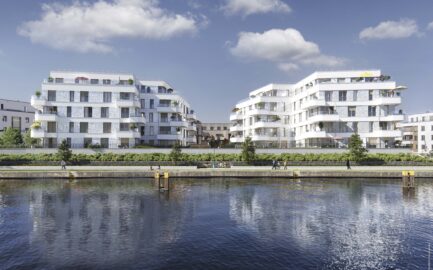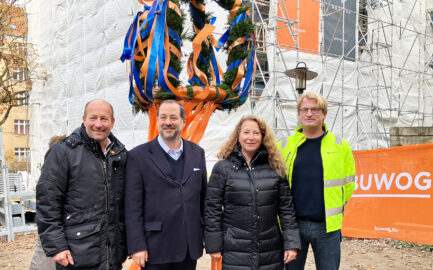The subject of electromobility, including the infrastructure for charging vehicles, is becoming increasingly important. In the sustainable design of BUWOG residential projects, the development of electromobility plays a vital role. But what are the current opportunities and obstacles for tenants and condominium owners with regard to an expanded service?
Sustainable living is just half the story if environmentally harmful means of transport are used to get to and from home. Thus, for the climate footprint of the housing system as a whole, mobility concepts that support the switch to low- or zero-emission means of transport are just as important as low-energy requirements for heating and cooling and sustainable energy production using solar or geothermal energy. In addition to car sharing, rental bicycles, sufficient bicycle parking and convenient public transport connections, mobility solutions in residential buildings are also increasingly aimed at the use of electric mobility. For whether it’s an electric car or electric bike, the vehicles are quiet and emission-free, they do not emit any air pollutants while in operation and they produce little or no particulate.
Theory: advantages and disadvantages
First, the contribution of electric vehicles to the reduction of greenhouse gases depends quite a bit on the energy sources used to produce the electricity. Electric cars also do not guarantee absolutely emission-free and resource-efficient mobility, as the production chain (extraction of raw materials such as lithium and cobalt for the batteries, production of steel or aluminium) sometimes requires an even greater amount of energy than conventional vehicles. The good news is: if you take into account the entire vehicle lifecycle (including production) and the domestic electricity mix, electric cars emit far less greenhouse gases than fossil fuel-powered vehicles
Practice: creating the right infrastructure
The array of various charging systems, the different connections and performance levels of the vehicles as well as the underlying legal framework can often be confusing. Most vehicle users want a simple solution for their new electric vehicle, where all they have to do is plug in to the outlet at home so the vehicle’s battery can be quickly recharged.
In practice, however the situation often looks entirely different: a wide range of different plugs and outlets, the required energy is not transmitted at the full power expected, and complex approval requirements (e.g. consent of the homeowners’ association, the homeowners or the authorities) have to be considered in order to install a charging device in the first place.
Charging stations in a rental property
As a rule, the building owner/lessor (or property management) must approve the installation of a charging station on a rental property.
In order to clarify the possibilities, the support of an electrical company is usually necessary as well. Under no circumstances should an installation be carried out arbitrarily. The overall situation is taken into account during the approval process; considerations include, for instance:
- Is the building’s overall connection extensive enough?
- Does load management make sense for the installation and for additional (future) charging stations?
- Can the line even be laid to the meter of the rental property?
- Are existing charging stations compatible?
- How will the installation affect the other tenants? Will normal electricity use continue? Where will the charging point be located?
- Will all safety precautions be observed?
Charging stations in condominiums
On 1 January 2022, new regulations in the Condominium Act became effective, in accordance with which the installation of a charging station is made easier for condominium owners under certain conditions. Essential information on the amendment to the Condominium Act can be found here. Details on legal and technical aspects can be found here.
Safety first: charging stations have to be maintained
Operators of a charging station are responsible for the safe operation and proper condition of the system and must therefore carry out regular maintenance. The maintenance as well as the corresponding documentation / results should be recorded in writing (test protocol / maintenance report). It is also recommended that the operational readiness be checked at regular intervals. Even the smallest defects in cables, plugs and/or housings can be life-threatening due to the high voltages. When planning the installation location in the underground car park, fire protection is also a central issue.
Outlook
At the moment, the demand from tenants and condominium owners is not yet too high. Nevertheless, there are still a number of questions to be clarified regarding the development of the charging infrastructure in order to further press ahead with the expansion of electromobility. What about the compatibility of different manufacturers? How can current control and utilisation be ensured if the charging stations have varying control systems? How is the intermediate storage of electricity organised? In order to help shape future developments and proposed solutions, BUWOG is now cooperating with e7, a research institution for energy and environmental technology. Because one thing seems certain: no matter how much electromobility helps us protect the climate, its full potential is far from exhausted.









